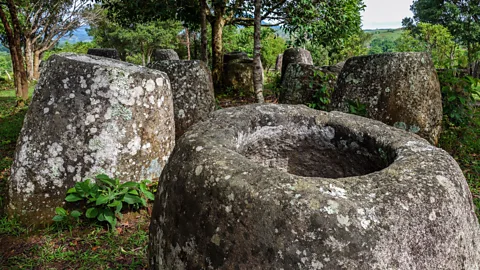You might be familiar with the majestic Angkor Wat, the ancient city of Ayutthaya, the historic San Agustin Church, or the iconic Singapore Botanical Garden. But have you discovered the Plain of Jars in Laos?
Plain of Jars is a mysterious archaeological site from the megalithic era, adorned with thousands of ancient stone jars scattered across the rocky landscape, holds secrets of an ancient civilization, perfect for captivating historians and travelers alike.
This site, with approximately 2,000 megalithic stone jars, is located in Xiengkhuang, Xiangkhouang province, Laos, and was recently listed as one of the World Heritage Sites in Southeast Asia, acknowledged by UNESCO. The Town of Luang Prabang was the first to be listed in 1995, followed by Vat Phou, which was listed in 2001.
Read also: Luang Prabang Ranked No.1 Destination in Laos
How was the Plain of Jars first discovered?

According to the Plain of Jars official site, it is noted that 129 stone jar sites have been explored by archaeologists. It was first discovered by Madeleine Colani, a French archaeologist, in the 1930s during her exploration of the Xiangkhouang region in Laos. The sites themselves are dated from between 500 BCE and 500 CE, also known as the Iron Age (and possibly as late as 800 CE), quoted from the World Heritage Convention UNESCO.
Two similar sites can also be found in Assam, Northeast India, where the geography and environment are nearly identical to the Laotian plateau, and the megalithic urns in Central Sulawesi, Indonesia, namely Kalambas, a large stone vat, also have similarities to urns in Laos.
Read also: Travel on a Budget? Let’s Go to Laos, The Cheapest Travel Destination for 2025

What is so special about this Plain of Jars?
Some of these tubular-shaped megalithic stone jars can reach an enormous size, up to 3 meters high and 1 meter wide, weighing several tons. Interestingly, apart from the jars, human bones, and stone discs were also discovered near the site.
It is no surprise that many archaeologists believe the jars were used as prehistoric burial sites or for funerary practices during the Iron Age. Others suggest the jars might have served as distilling vessels in early funeral rites. In this theory, a body would be placed in a jar to decompose before being moved to a crematorium. Once fully decayed, the remains would be returned to the urn, and the process would repeat for new corpses.
Could you imagine how much effort it took to just bury the body of a loved one in ancient times? Starting from crafting the jars that are assumed to use iron chisels and technological skill to produce then moving from the quarry locations to the funerary sites.
However, intriguing local legends claim the jars were used to brew rice wine for victorious giants or to hold whisky for a giant in the mountains above Phonsavan. Therefore, the truth remains a mystery to this day.
What makes it even more special is that it is not only located at a historical crossroads between two major Iron Age cultures in Southeast Asia—the Mekong River and the Gulf of Tonkin—but also a highly strategic location during the long Southeast Asian war, where the area was home to several airfields. Due to the past war, there are still some unexploded bombs on the sites that have not been detonated and left unexplored.
How to visit the Plain of Jars?
Fortunately, history lovers and visitors curious about another side of the history of Laos can now easily get to know these megalithic jars at the Plain of Jars Visitor Center, where you can visit the Plain of Jars' main sites (e.g., Site 1, Site 2, and Site 3) by joining a guided tour that also provides detailed insights about the history and information of the jars.
Another option is to explore independently by renting a motorbike or hiring a private vehicle if you want more flexibility to explore the jars and the surrounding countryside. In addition, the best time to visit is during the dry season between November to March, when the weather is pleasant and the roads are more accessible.
So, are you interested and ready to explore this lesser-known place in Laos and add it to your next adventure list? Or will you try to uncover the origin story of the Plain of Jars like any other archaeologist?



















